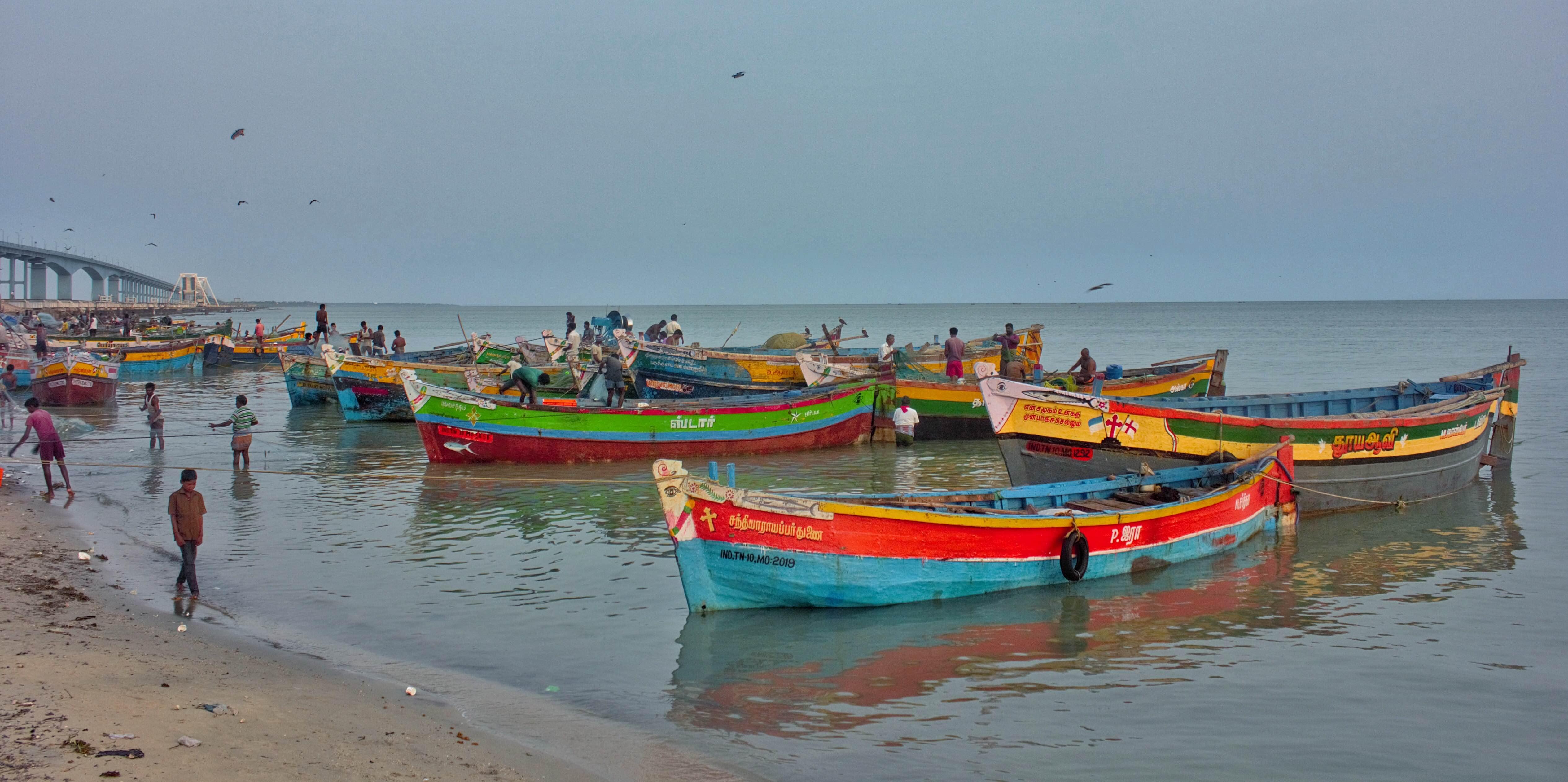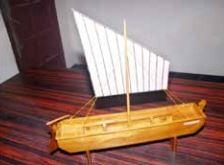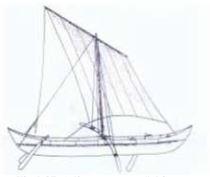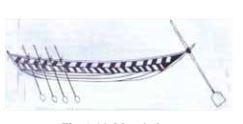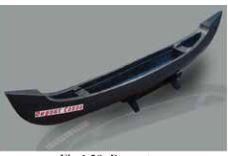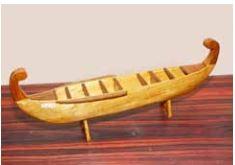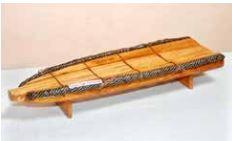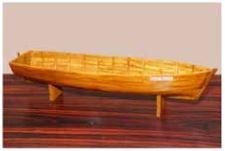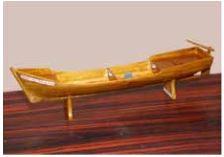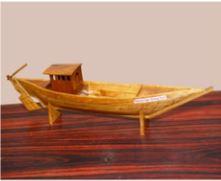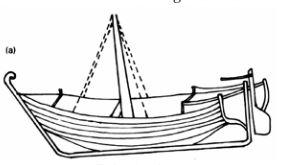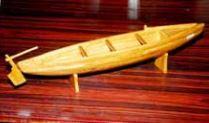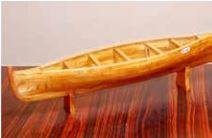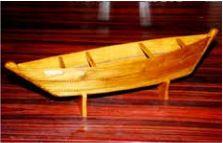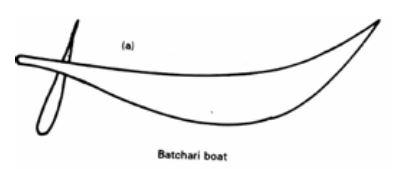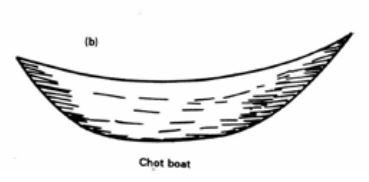Fishing boats in India
Fishing boats in India
- Marine Fishing crafts in India
- Fishing boats of Tamil Nadu
- Fishing boats of Goa
- Fishing boats of Karnataka
- Fishing boats of Kerala
- Fishing boats of Maharashtra
- Fishing boats of Gujarat
- Fishing boats of Andhra Pradesh
- Fishing boats of Odisha
- Fishing boats of West Bengal
- Fishing boats of Andaman and Nicobar Islands
- Fishing boats of Lakshadweep Islands
Marine Fishing crafts in India
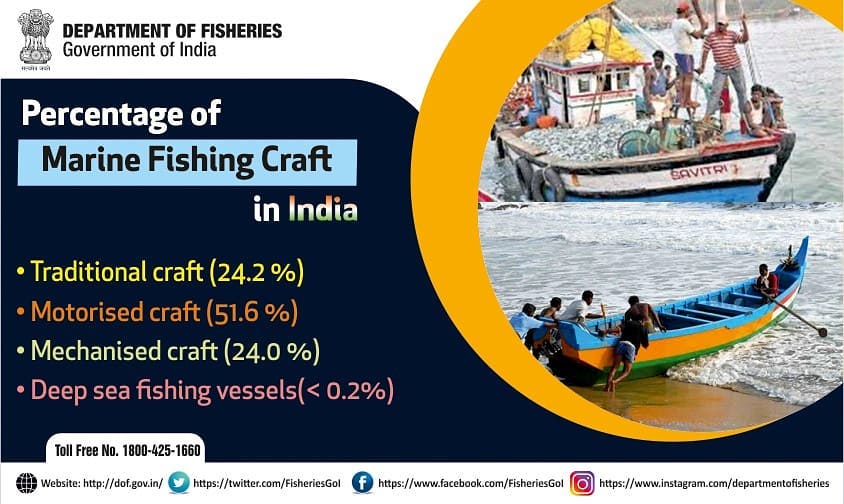
Fishing boats of Tamil Nadu
Colachel to cape Comorin is a surf beaten coast where boat catamarans are popular. In the Gulf of Mannar, boat canoe, boat catamaran, Tuticorin and Kilakarai boats are in operation. Popular craft in Palk Bay is fishing canoe, Adiram patnam canoe, three masted plank-built canoe and kalla dhoni. In Coromandel coast catamarans and flexible, masula boats are predominant.
Boat Catamaran
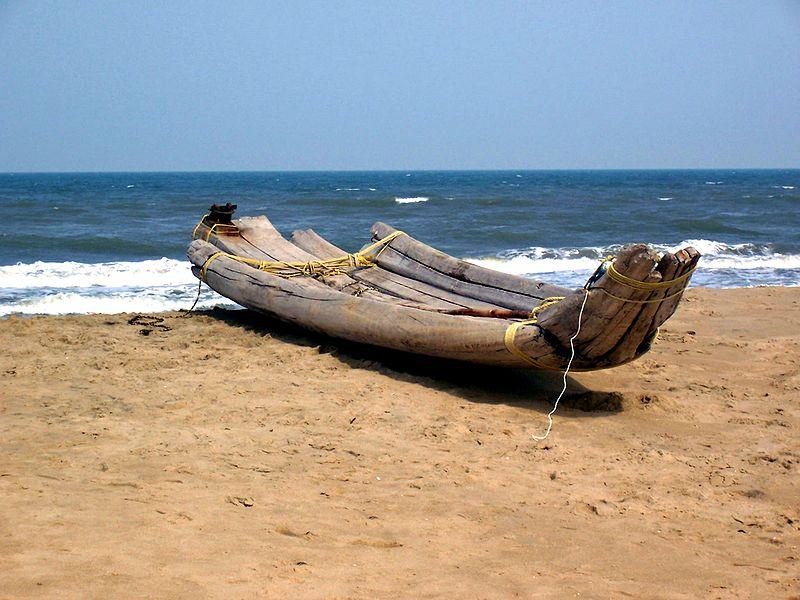
- It is made of three logs, the centre one fitted at a lower level than the other two giving it a boat shape.
- The logs are held using two blocks of wood on either end and secured by coir ropes passing through the grooves on the side of the logs.
- Size varies from 6.5 – 7.5 m
- Small triangular sail is used
- Usually operated in pairs for boat seiners
Boat canoe (Vallam)
- Similar to Malabar dugout but spread by wedges and heightened by flared 22-25 cm wash strakes.
- Length varies from 9-13 m
- Single mast at amidships with lug sail. In larger ones, mizzen mast is also carried.
- The Large rudder is fitted which descends much below the round bottom.
- Used for an operation of gill nets and long lines.
Tuticorin boat
- It measures 9.6 x 2.0 x 0.9 m
- Long, relatively narrow with nearly vertical stem and stern
- Sheer line is almost straight.
- Single mast with lug sail
- Frames are not carried up to the gunwale but cut away at the sheer plank. The upper most planks are framed with a separate short piece not fastened to the main frame.
Adirampatnam fishing canoe
- Hull is a dugout canoe with wash strakes
- There is a pair of quarter steering boards instead of fixed rudder.
- Single mast, occasionally three masts are used
- For steering the boat, quarter boards are manipulated with feet by steer man
- The balance board is exceptionally long
Kilakaral boat
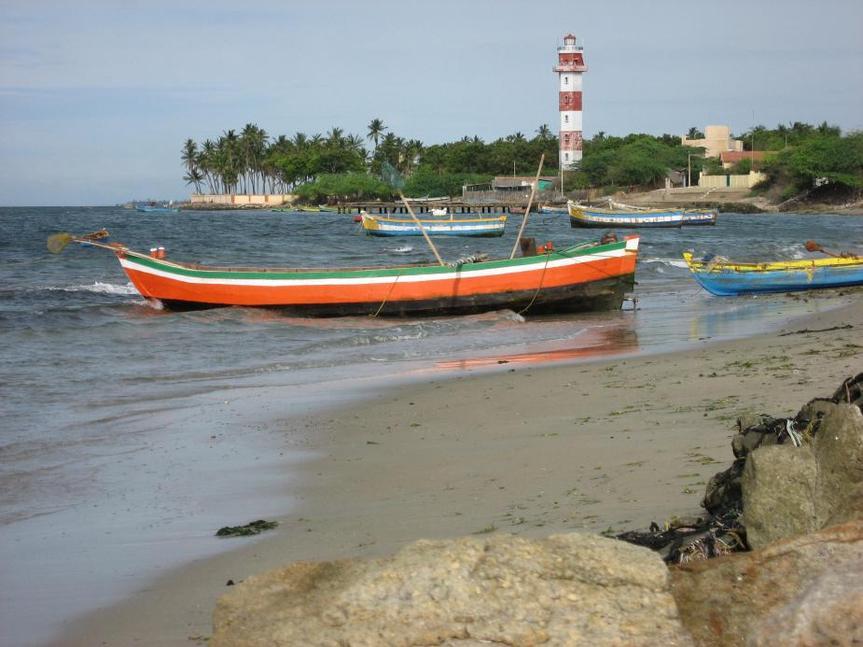
- It is similar to Malabar dugout with additional vertical stakes.
- Provided with either one or two out riggers for stability
- Single mast with lug sail
- Uses temporary rudder fixed at the sharp curved stern by Orthodox pintle and gudgeon
Masula boat
- Size measures 9 x 2.4 x 1.2 m
- Open boats without ribs
- Planks are sewn with coir rope and inter space is filled with dry straw
- Stem and stern are raked, keel narrow
- High free board
- No mast or sail, long paddles are used
- Used for operation of shore seiners
Fishing boats of Goa
The traditional fishing craft of Goa is dugout canoes and planked boats with large out riggers. There is a rudimentary keel in the dugouts. The size of the boat varies from 7-8 m.
Fishing boats of Karnataka
Rampini boats are popular in Northern Karnataka and dugout in Southern Karnataka.
Fishing boats of Kerala
- Dugout
- Plank built canoe
- Raft Catamaran
Dugout
- Single logs of trees like mango and aini are scooped for its construction.
- Three types of dugouts are found to be in operation. They are
- Large ones are known as Odam – 11.6 m length.
- Medium ones are known as Thonies – 8 m length
- Smaller ones are known as Bepu thoni – 7.5 m length
- They are propelled by paddles and sails. Sails are either square or sprit type. No rudder is used. Steering is utilizing big paddle one-quarter side.
- Larger ones operate boat seines and smaller one's gill nets and lines
Plank built canoes
- Built with planks which are sewn with coir ropes
- Propelled employing paddles and occasionally sails.
- Two types are distinguished i.e.
- Larger one– 12 x 1.5 x 0.8 m,
- Smaller one 7 x 1 x 0.6 m
- Used for operation of shore seines and gill nets
Raft catamaran
- It is constructed by tying 3-5 logs of soft wood with coir ropes
- Propelled by split bamboo oars and sails
- Used in pairs to operate boat seines and individually to operate gill nets and long lines.
Fishing boats of Maharashtra
The physical and geographical features of northern Maharashtra up to Mumbai are similar to those of southern Gujarat. Southern Maharashtra has a rocky coast with sheltered bays, creeks and harbours. The following types of fishing boats are found in Maharashtra.
Bombay machwa
- Length 15 m, breadth 3-5 m, and depth 1 m
- Long raking bow with great over hang and sheer. The actual keel is short to the overall length.
- There are two masts, and sails are of lateen type.
Satpati type
- Length ranges from 10-15 m
- Carvel planking
- Medium pointed bow, broad stem, straight keel, high gunwale, and transom stern
- Used for gill netting
Versova boat
- Arched keel, round stern, and deep fore foot
- Stem less raked than Bassein boat, it resembles Bassein boat in other respects
- Aft deck is present but no fore deck
- Used for the operation of dol nets.
Rathnagiri machwa
- Length 10 m, breadth 3 m, and depth 1.15 m
- Broad beam, long over hanging bow, round stern and raked stem post
- Open boat with low free board, single mast lateen sail
- Used for deep sea gill net fishing
Fishing boats of Gujarat
There is a marked difference in the geographical and physical features of northern and southern regions of Gujarat. Whereas the north of the country is arid and stony, the south of the country is distinguished by the sandy bottom. The following types of a boat with their broad features give along side are found in Gujarat.
Porbandar machwa
Cambay Machwa
- Length varies from 6-8 m
- Square stern and raked stem
- Used for gill net fishing
Malia boat
- The flat bottom boat which measures about 6-7 m in length, breadth 1.5 m with 65 cm draft.
- Ends are pointed, and there is small rudder
- Carvel planking
- Mast carries a lateen sail
- Small decking fore and aft
- Used in tidal waters for prawn fishery
Dugout canoe
- Double – ended round bottom boat
- Length varies from 5-9 m, breadth 60-90 cm, and depth 60-68 cm
- Small sail raised on a wooden mast
- Used for gill netting
Madhwad type wahan
Gujarat wahan
- Length 10-13 m and breadth 2-3 m
- Raked stem and square stern
- Decked at the fore and aft
- Large heavy rudder
- Mast with lateen soil
- Used for operation of gill nets and dol nets
Fishing boats of Andhra Pradesh
Being surf beaten coasts without shelters, the following surf – landing crafts are predominant
Catamaran (Teppalu)
- Made of 4 logs, it is 6.6 m long and 1.35 m broad.
- All logs end in a line, unlike coromandel catamarans. Wash boards are attached at the sides.
- Triangular sails are used from a bamboo mast. Paddles of 1.5 m long are used.
- Used for operating gill nets, lines and boat seines
Masula boat
Similar to the one described under Coromandel coast excepting some minor details its planks are made of mango wood and stitched with palmirah leaf fibre keeping a continuous rope in between the seams.
Nava
- It measures 10 x 2 x 0.7 m
- Narrow round bottom boat without keel, heavy framed and carvel planked with a short fore deck and longer aft deck
- Carries one mast and a lateen sail
- Mainly used for operation of gill nets
Fishing boats of Odisha
Two regions can be differentiated along the Odisha coast. The southern part is surf beaten, where as the northern part has sandy bottom extending far out into the sea. The boats used are
Botali
- It measures 7 x 1.5 x 1.5 m
- Vertical and pointed stem and stern with full amidships section
- Both carvel and clinker planking are seen
- Used for operation of gill nets
Catamaran
- Five logs are tied in a boat shape, front portion being narrowed to a point and aft part abruptly truncated.
- Used for the operation of gill nets, boat seines are also operated occasionally.
Bar boat
- It measured 8 m long and 2.5 m broad
- Similar to masula type
- No ribs or frames and planks are stitched with coir ropes
Fishing boats of West Bengal
The physical conditions of the coast line are analogous to those of northern Odisha. The following two boats are used.
Batchari boat
- It measures 13.5 m x 1.3 m x 0.5 m
- The stern is as high as bow, and they are sharp and raked.
- They are partly decked without keel
- Propelled by sails and oars
- Used for operation of variety of gears like drift net, bag net, dip net etc.,
Chot boat
- It measures 10.2 x 2.5 x 1.1 m
- It has short overhangs and high freeboard
- Mostly propelled by oars though it carries a sprit sail
- There is only a loose decking of split bamboo rods
- Used for operation of heavier fishing gears like seine nets and bag nets
Fishing boats of Andaman and Nicobar Islands
Influence of Australian design is seen in the fishing craft of these Islands. Dugout and out rigger canoes are standard. However, the shape of dugouts is different, and the outrigger canoes have more than two out riggers attached differently.
Dugout
- Length varies from 2.75 m – 10.5 m
- The bow and stern are prolonged horizontally to form an overhang shelf platform which gives footing for the harpooners on look out for fish.
- Propulsion is using oars, steering with paddle
- Holes are made in the gunwale on each side, and a piece of wood is thrust through them as a sort of thwart. This is to provide a means for fastening the end of harpoon line.
Out rigger canoe
- It is provided with multiple booms varying from 3-12 m. These booms are slender poles secured at their inner ends by being passed through the holes on the sides of dugout close to the edge. This is similar to the design found in Australia.
- Floats are connected to the booms utilizing three short stanchions.
Fishing boats of Lakshadweep Islands
Raft (Kathufathi)
- 5-6 logs are tied into raft utilizing two coconut poles and fastened by coir ropes
- Propulsion is by paddles
- Used for hook and line operation.
Plank built boat (Kalundhoni)
- Both stem and stern are slightly curved. Stern is broader than the bow.
- Keel is a single piece of coconut palm or wood
- Oars and sails are used for propulsion. The rudder is fixed over the skeg.
- The boat is divided into seven compartments by transverse planks.
- Used for pole and line fishing.
Masodi
- It measures 12.5 m in length and 3 m broad
- The stern is broader than the bow and is provided with a fishing platform
- The boat carries two lateen sails and 18 oars for rowing
- The hull is divided into 12 compartments, and two bait tanks are provided
- Used for pole and line fishing.
Sources
- Badapanda, K.C. 2013. Fishing Craft and Gear Technology: Basics of Fisheries Science, Volume 3. Narendra Publishing House, New Delhi.
- Meenakumari, B., Boopendranath, M. R., Pravin, P., Thomas, S. N., and Edwin, L. 2009. Handbook of fishing technology. (Ed.). Central Institute of Fisheries Technology, Cochin.
- Sreekrishna, Y. and Shenoy, L., 2001. Fishing gear and craft technology. Indian Council of Agricultural Research, New Delhi.
Last Modified : 6/25/2024
